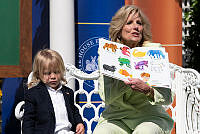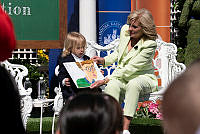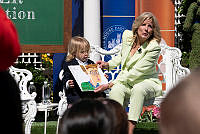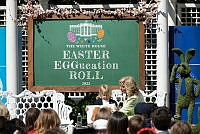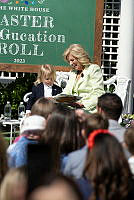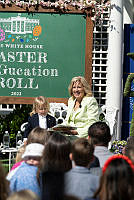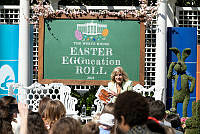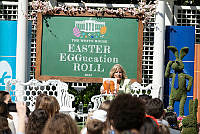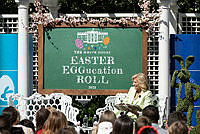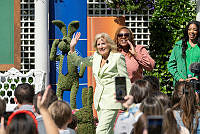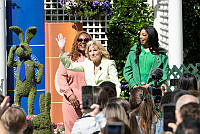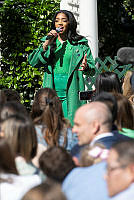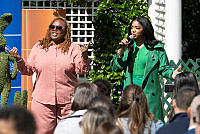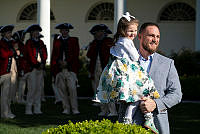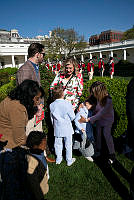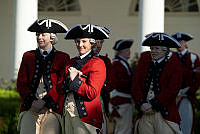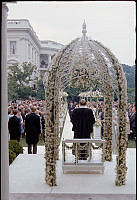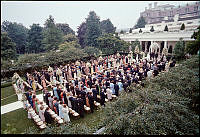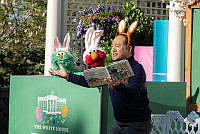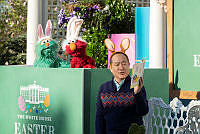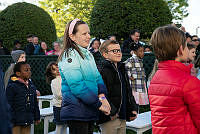Nash Castro: A Board Member's Role with the Kennedy Rose Garden
A Reflection: White House History Number 38
Copyright © Summer 2015 White House Historical Association. All rights reserved under international copyright conventions. No part of this article may be reproduced or utilized in any form or by any means, electronic or mechanical, including photocopying, recording, or by any information storage and retrieval system, without permission in writing from the publisher. Requests for reprint permissions should be addressed to books@whha.org
I recently had the opportunity to visit with Nash Castro, the last surviving founder of the White House Historical Association, who also played a role in the story of the Rose Garden while serving as liaison to the White House for the National Park Service during the Kennedy administration. His influence would be even stronger in the Johnson administration, when he provided assistance to Mrs. Johnson on projects related to her love of the natural world. That longer story is for a later issue.
Mr. Castro, with his wife the poet Bette Woolsey Castro, moved to Washington in June 1961, as assistant superintendent of administration of the National Capital Parks under then-superintendent T. Sutton Jett. Mr. Castro was designated as the Park Service’s liaison to the White House, a unit of the National Park System.
Mrs. Kennedy undertook the challenging restoration of the White House with high hopes but without money being available for the purpose. She asked J.B. West, the Chief Usher, and Mr. Castro to visit the publisher of The Saturday Evening Post in Philadelphia and determine whether the Post could produce postcards of the White House for sale to its visitors. The publisher assured his visitors that he could produce the cards. On the return trip Mr. Castro asked Mr. West to tell Mrs. Kennedy that he thought it would be undignified to sell post cards in the White House. Mrs. Kennedy agreed and conceived the idea of the guidebook instead. Her own letters confirm this.

Thus, the White House Historical Association was born as a private, non-profit support organization for the White House. Mr. Castro remains on the board of directors. To publish the guide, Mr. Castro turned to Mr. Conrad L. Wirth, Director of the National Park Service and a member of the board of the National Geographic Society, to help with the venture. Under the direction of Melville Grosvenor, Chairman of the Geographic, its staff produced the guidebook in record time, the text having been written by Lorraine Pearce, the first White House curator.
Copies of the guidebook were presented to President and Mrs. Kennedy on June 28, 1962, in the Roosevelt Room in the West Wing of the White House. The first copies were sold to the public on July 4, 1962, and sales quickly totalled more than one million. Now in its 23rd edition, the White House Historical Association has kept the guide in print for more than fifty years.

Rose Garden patio.
The White House Historical AssociationOf the many projects that came to Mr. Castro with the Kennedy administration, the Rose Garden was notable second only in popular acclaim to the state interiors featured in the White House: An Historic Guide. Here there was no committee, at least in the usual sense. It was to be Rachel Lambert Mellon’s and President Kennedy’s garden. Mr. Castro remembers, “Mrs. Mellon designed the Rose Garden. I’ll never forget, I was invited to her house in Georgetown. I was invited because she wanted to talk to me about her vision for the Rose Garden. That morning I sat in her living room, where she had this vast, great, great collection of world-class paintings by everybody. Monet and all of them. I sat there absolutely dazzled looking around. She sat on the sofa and took a pad like this [holds up pad] and she sketched in pencil what her vision was for the Rose Garden.” Apparently there was no back and forth discussion. This was as she intended to have it. Mr. Castro was always there seeing that efforts worked, as the Rose Garden took form. Many a tangle he untied quietly, as was his style.
When all was done, Nash Castro remembers one event after the President’s death that closed the Kennedy administration for him. The rooms decorated, the Rose Garden revised, and visionary projects in their infancy on Lafayette Square, he remembers warmly that day when a White House courier appeared at the National Park Service headquarters with a White House formal envelope containing a note of profound thanks, signed, “Jacqueline Kennedy.”

Stewart McLaurin, President, White House Historical Association














